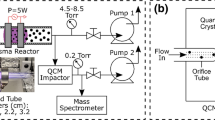Abstract
The formation and growth of silicon-nanoparticles from silane in a microwave reactor was investigated. Experiments were performed for the following conditions: precursor concentration 380–2530 ppm, pressures of 20–30 mbar, microwave powers 120–300 W. The formed particles were examined in-situ with a particle mass spectrometer. Additionally, particles were collected on grids and analyzed by transmission electron microscopy, X-ray diffraction, and by determining the specific surface area by BET. The particle size was found to be in the range of 5–8 nm in diameter. A simple model was used to simulate the particle formation processes taking place inside the reactor. The microwave energy coupled into the reactor flow was treated as a spatially distributed energy source resulting in a local temperature increase. The particles were assumed to have a monodisperse size distribution. To allow an approximation of their shape they were characterized by their volume and surface area. The model takes nucleation, convection, coagulation, and coalescence into account. The fluid flow inside the microwave reactor was simulated with the commercial CFD-code Fluent.
Similar content being viewed by others
Abbreviations
- a p0 :
-
surface area of a monomer [m2]
- A :
-
total surface area per unit volume [1/m]
- A min :
-
minimal total surface area per unit volume [1/m]
- c i :
-
concentration of species i [mol i /m3]
- D :
-
diffusion coefficient for the user defined scalar in Fluent
- D gb :
-
grain boundary diffusion coefficient [m2/s]
- d pp :
-
diameter of a primary particle [m]
- \(\vec{f}\) :
-
flux function for the user defined scalar in Fluent
- J :
-
nucleation rate [kg/m3s]
- Kn :
-
Knudsen number
- k :
-
reaction coefficient
- k B :
-
Boltzman constant [J/K]
- L :
-
average grain size [m]
- N :
-
number concentration of the agglomerates [1/m3]
- NA:
-
Avogadro constant [1/mol]
- n pp :
-
number of primary particles of an agglomerate
- P MW :
-
power of the microwave generator [W]
- p :
-
pressure [mbar]
- R:
-
gas constant [J/mol K]
- R :
-
reaction rate [mol/m3s]
- S :
-
source term for the user defined scalar in Fluent
- T :
-
temperature [K]
- t :
-
time [s]
- V :
-
total particle volume per unit volume [1]
- V MW :
-
volume into which the microwave energy is coupled [m3]
- v pp :
-
volume of a primary particle [m3]
- v p :
-
particle volume [m3]
- \(v_{\rm p}^0\) :
-
volume of a monomer [m3]
- \(\vec{w}\) :
-
velocity of the aerosol [m/s]
- w :
-
grain boundary width [m]
- \(\beta_{v_{\rm p}}\) :
-
collision kernel of two particles with volume v p [m3/s]
- γ:
-
surface tension [J/m2]
- μ G :
-
viscosity of the gas phase [Pas]
- ϕ:
-
user defined scalar in Fluent
- ρ:
-
density of the aerosol [kg/m3]
- \(\rho_{\rm p}^0\) :
-
density of the particle material [kg/m3]
- τ:
-
characteristic sintering time [s]
- Ω:
-
molar volume of diffusing species [m3/kg]
References
A. Edelstein & R. Cammarata (Eds) (1996) Nanomaterials: Synthesis, Properties and Applications Institute of Physics Publishing Ltd Bristol
Fluent 2000. Fluent User’s Guide, Version 5.5. Fluent Inc., Computational Fluid Dynamics Software, Centerra Resource Park, 10 Cavendish Court, Lebanon, NH 03766
Janzen C., H. Wiggers, J. Knipping & P. Roth, 2001. J. Nanosci. Nanotechnol. 1, 221
H. Kleinwechter C. Janzen J. Knipping H. Wiggers P. Roth (2002) ArticleTitleFormation and properties of ZnO nano-particles from gas phase synthesis processes J. Mater. Sci. 37 4349–4360
F. Kruis K. Kusters S. Pratsinis B. Scarlett (1993) ArticleTitleA simple model for the evolution of the characteristics of aggregate particles undergoing coagulation and sintering Aerosol Sci. Technol. 19 514–526
Lindackers D., C. Janzen, B. Rellinghaus, E. Wassermann & P. Roth, 1998, Nanostruct. Mater. 10, 1247
Lindackers D., M. Strecker, P. Roth, C. Janzen & S. Pratsinis, 1997. Combust. Sci. Technol. 123, 287
P. Melinon V. Paillard V. Dupuis A. Perez P. Jensen A. Hoareau J. Perez J. Tuaillon M. Broyer J. Vialle M. Pellarin B. Baguenard J. Lerme (1995) ArticleTitleFrom free clusters to cluster-assembled materials Int. J. Mod. Phys. B 9 339–397
Proot J., C. Delerue, & G. Allan, 1992. Appl. Phys. Lett. 61, 1948
Roth P. & A. Hospital, 1994. J. Aerosol Sci. 25, 61
B. Warren (1969) X-Ray Diffraction Dover Publications, Inc. New York 259
D. Woiki A. Kunz P. Roth (2000) ArticleTitleChemicl reactions of aerosol precursors J. Aerosol Sci. Suppl 1 212–213
Y. Xing D. Rosner (1999) ArticleTitlePrediction of spherule size in gas phase nanoparticle synthesis J. Nanoparticle Res. 1 277–291
Author information
Authors and Affiliations
Corresponding author
Rights and permissions
About this article
Cite this article
Giesen, B., Wiggers, H., Kowalik, A. et al. Formation of Si-nanoparticles in a microwave reactor: Comparison between experiments and modelling. J Nanopart Res 7, 29–41 (2005). https://doi.org/10.1007/s11051-005-0316-z
Received:
Accepted:
Issue Date:
DOI: https://doi.org/10.1007/s11051-005-0316-z



